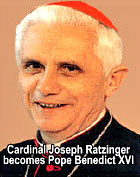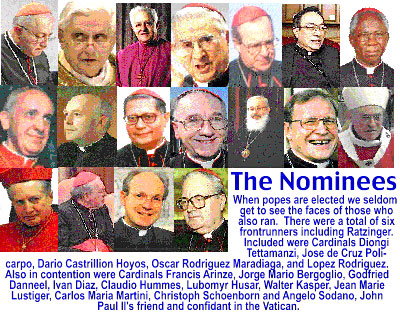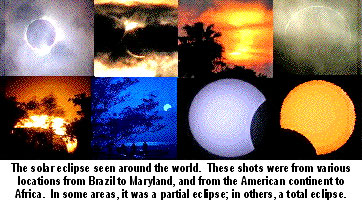|

by
Jon Christian Ryter
April 19, 2005
from
JonChistianRyter Website
 Only two days and four ballots into the
election process to select a new pontiff for the Roman Catholic
Church, Germany’s Cardinal Joseph Ratzinger emerged as the
new pontiff, taking the name Pope Benedict XVI, and raising
the specter that he may have unwittingly—at and least partially—
fulfilled a prophecy uttered by St. Benedict (b.480-d.547AD)
that the last pope of Roman Catholic would be a
Benedictine. While Ratzinger was never an Olivetan
monk, there is a certain prophetic irony in the papal name he
chose. A second irony may come from St. Malachy’s prophecy
itself. In his prophecy, the 12th century cardinal
described the last pope by the symbol, Glory of the Olives.
While those speculating what the term means naturally connected
olives with the olive branch—which denotes peace—and
saw the last pope as a peacemaker who would likely help bring
peace to the Middle East. A peaceful solution to the
dilemma between the Palestinians and the Jews is a precursor to
Bible prophesies concerning the end-times. Perhaps the analogy is
even more simple: Only two days and four ballots into the
election process to select a new pontiff for the Roman Catholic
Church, Germany’s Cardinal Joseph Ratzinger emerged as the
new pontiff, taking the name Pope Benedict XVI, and raising
the specter that he may have unwittingly—at and least partially—
fulfilled a prophecy uttered by St. Benedict (b.480-d.547AD)
that the last pope of Roman Catholic would be a
Benedictine. While Ratzinger was never an Olivetan
monk, there is a certain prophetic irony in the papal name he
chose. A second irony may come from St. Malachy’s prophecy
itself. In his prophecy, the 12th century cardinal
described the last pope by the symbol, Glory of the Olives.
While those speculating what the term means naturally connected
olives with the olive branch—which denotes peace—and
saw the last pope as a peacemaker who would likely help bring
peace to the Middle East. A peaceful solution to the
dilemma between the Palestinians and the Jews is a precursor to
Bible prophesies concerning the end-times. Perhaps the analogy is
even more simple:
the Benedictines were
Olivetan monks, and its leader, rightfully, can be
construed as the glory of the olives.
Time will tell. And time is running out.
With respect to the conclave that met
and selected a new pontiff in what tied as the second fastest papal
election in this century, if popes were picked like ponies, the
bookmakers favoring John Paull II’s closest friend,
Cardinal Ratzinger of Germany would have crowned him with a
wreath of roses as they would the winner of racing’s Triple
Crown (image right... ) By the time of
Pope John Paul II’s funeral on April
8, Ratzinger had 50 of the 78 votes he needed to assure his victory
already in his pocket. With only 115 eligible voters (two eligible
cardinals, one from Mexico and one from the Philippines were sick
and did not come) Ratzinger, known as the Dean of the Cardinals,
still needed to pull 28 additional ballots out of his hat to win in
the opening rounds of voting where 2/3 of the cardinals had to agree
before the pontificating of a candidate could occur. It did not seem
likely, with the cultural differences of the cardinals and the
liberal or conservative personal agendas that each of them who
actively campaigned for the job carried with them into the Sistine
Chapel on April 18, that either of the two key front-runners would
win since it appeared more likely that gridlock would kill Ratzinger
and Italian Cardinal Dionigi Tettamanz’s chances of winning. When
Ratzinger failed to score a first or second ballot victory, the
oddsmakers raised him from the 4-to-1 favorite to a 7-to-1 maybe.
Many of the newly anointed bishops and cardinals also favored
Cardinal Angelo Sodano who greatly influenced the decisions of John
Paul II on "promotions" within the Catholic hierarchy. Sodano played
a key role in selecting all of the cardinals appointed from 2001
until the death of his benefactor and friend, John Paul II. Although
popular with the Italian laity, Sodano was clearly out of the
running before the running even began. He knew he would never get
the nod from the conclave because his influence died as the last
breath passed from the lips of John Paul II. The political cardinals
in the Vatican threw their support behind Ratzinger. Anyone who
believes that Cardinal Ratzinger’s elevation was God-ordained
through prayer and not politically-manipulated by a master
politician simply doesn’t understand the art of campaigning for
office.
The three most influential voting blocks in the conclave were the
Italians—with 20 votes, the United States—with 11 votes and the
Spanish-speaking nations, which collectively had 22 votes. There
were 17 votes each in North and South America, giving the western
hemisphere cardinals a bloc of 34 votes. Europe has enough votes to
elect a pope without the consensus of any other continent—58
votes—if ten days elapsed without naming a pope. Had that happened,
very likely a compromise candidate from one of the emerging
Spanish-speaking nations would have been selected.
But, in the final analysis, Cardinal Ratzinger, who had a
deliberate, well-calculated plan to win the job, won the job.
Reportedly Ratzinger was already campaigning for the job when the
Vatican announced that the death of John Paul II was imminent.
Ratzinger really wanted to be the pontiff (unlike his friend, Polish
Cardinal Karol Wojtkyla who not only did not campaign for the
job—but was surprised when he got it).

As the Conclave of Cardinals met on Monday, April 18, 2005 to select
the replacement for Pope John Paul II, few people in the world were
aware that the bizarre hybrid eclipse witnessed by millions of
people around the world on April 8, 2005 was prophesied by a
Catholic cardinal in 1140 AD specifically as a sign for that
pontiff. Pope John Paul II was described by 12th century Roman
Catholic Cardinal Malachy as "De Lobaore solis" (Of the eclipse of
the sun).

The Malachy Prophecy, penned by
Cardinal Malachy while on
his way to Rome for the coronation of Innocent II, described by
symbol, the papal succession from Celestine II (the pope would
succeed Innocent II) to the end of the world. Interestingly, on the
day of his birth, a solar eclipse occurred that was visible over
Poland—the nation of Karol Wojtkyla—the man who become pontiff of
the Roman Catholic Church.
By the time of John Paul II’s death, the Malachy Prophecy has
proven
to be 98% accurate. Whether or not it proves to be 100% accurate
will depend on whether or not any other pontiffs follow the pope who
was symbolically described as Gloria Olivae (the glory of the
olives)—and whether the events known as the Rapture and
the
Tribulation commence during the reign of Pope Benedict XVI.
 When the description of this uncommon hybrid type of eclipse
appeared in the article
The Malachy Prophecy scant
hours before the eclipse began to appear, the site received scores
of emails from readers poophahing the notion that an eclipse
alternating from a partial to a total eclipse would circumvent the
globe. While anular eclipses are a rare phenomenon, they are not
unknown. The April 8 hybrid eclipse was visible from within an
angular corridor that was predominantly visible from the southern
hemisphere. The total eclipse, which began southeast of New Zealand
traveling on a narrow band 28 kilometers wide quickly narrowed to a
sliver within the first 13 minutes of its journey past of Tahiti on
its way to Pitcairn Island. It continued on a northeastern course as
it crossed the Pacific Ocean to Panama, Columbia and Venezuela. (One
of the photos, above, was taken on
Pitcairn Island). The moon’s
penumbral shadow cast a wide swath across half of the planet,
covering all of New Zealand, Australia, the South Pacific islands
and much of South and North America from southern California on the
west coast to New Jersey on the east coast. Over a period of 3 hours
and 24 minutes, the eclipse traveled 14,200 kilometers. When the description of this uncommon hybrid type of eclipse
appeared in the article
The Malachy Prophecy scant
hours before the eclipse began to appear, the site received scores
of emails from readers poophahing the notion that an eclipse
alternating from a partial to a total eclipse would circumvent the
globe. While anular eclipses are a rare phenomenon, they are not
unknown. The April 8 hybrid eclipse was visible from within an
angular corridor that was predominantly visible from the southern
hemisphere. The total eclipse, which began southeast of New Zealand
traveling on a narrow band 28 kilometers wide quickly narrowed to a
sliver within the first 13 minutes of its journey past of Tahiti on
its way to Pitcairn Island. It continued on a northeastern course as
it crossed the Pacific Ocean to Panama, Columbia and Venezuela. (One
of the photos, above, was taken on
Pitcairn Island). The moon’s
penumbral shadow cast a wide swath across half of the planet,
covering all of New Zealand, Australia, the South Pacific islands
and much of South and North America from southern California on the
west coast to New Jersey on the east coast. Over a period of 3 hours
and 24 minutes, the eclipse traveled 14,200 kilometers.
The first recorded annular eclipse (a hybrid that switches from a
total to a partial eclipse and back again) occurred on May 6,
1464—30 years before Christopher Columbus set sail on a journey that
would bring him to the New World. The next hybrid eclipse will occur
on April 20, 2023.
|

 Only two days and four ballots into the
election process to select a new pontiff for the Roman Catholic
Church, Germany’s Cardinal Joseph Ratzinger emerged as the
new pontiff, taking the name Pope Benedict XVI, and raising
the specter that he may have unwittingly—at and least partially—
fulfilled a prophecy uttered by St. Benedict (b.480-d.547AD)
that the last pope of Roman Catholic would be a
Benedictine. While Ratzinger was never an Olivetan
monk, there is a certain prophetic irony in the papal name he
chose. A second irony may come from St. Malachy’s prophecy
itself. In his prophecy, the 12th century cardinal
described the last pope by the symbol, Glory of the Olives.
While those speculating what the term means naturally connected
olives with the olive branch—which denotes peace—and
saw the last pope as a peacemaker who would likely help bring
peace to the Middle East. A peaceful solution to the
dilemma between the Palestinians and the Jews is a precursor to
Bible prophesies concerning the end-times. Perhaps the analogy is
even more simple:
Only two days and four ballots into the
election process to select a new pontiff for the Roman Catholic
Church, Germany’s Cardinal Joseph Ratzinger emerged as the
new pontiff, taking the name Pope Benedict XVI, and raising
the specter that he may have unwittingly—at and least partially—
fulfilled a prophecy uttered by St. Benedict (b.480-d.547AD)
that the last pope of Roman Catholic would be a
Benedictine. While Ratzinger was never an Olivetan
monk, there is a certain prophetic irony in the papal name he
chose. A second irony may come from St. Malachy’s prophecy
itself. In his prophecy, the 12th century cardinal
described the last pope by the symbol, Glory of the Olives.
While those speculating what the term means naturally connected
olives with the olive branch—which denotes peace—and
saw the last pope as a peacemaker who would likely help bring
peace to the Middle East. A peaceful solution to the
dilemma between the Palestinians and the Jews is a precursor to
Bible prophesies concerning the end-times. Perhaps the analogy is
even more simple: 

 When the description of this uncommon hybrid type of eclipse
appeared in the article
When the description of this uncommon hybrid type of eclipse
appeared in the article